How to Share Energy Resources With Your Community in Times of Need
A partnership of Shareable and People Power Battery Collective
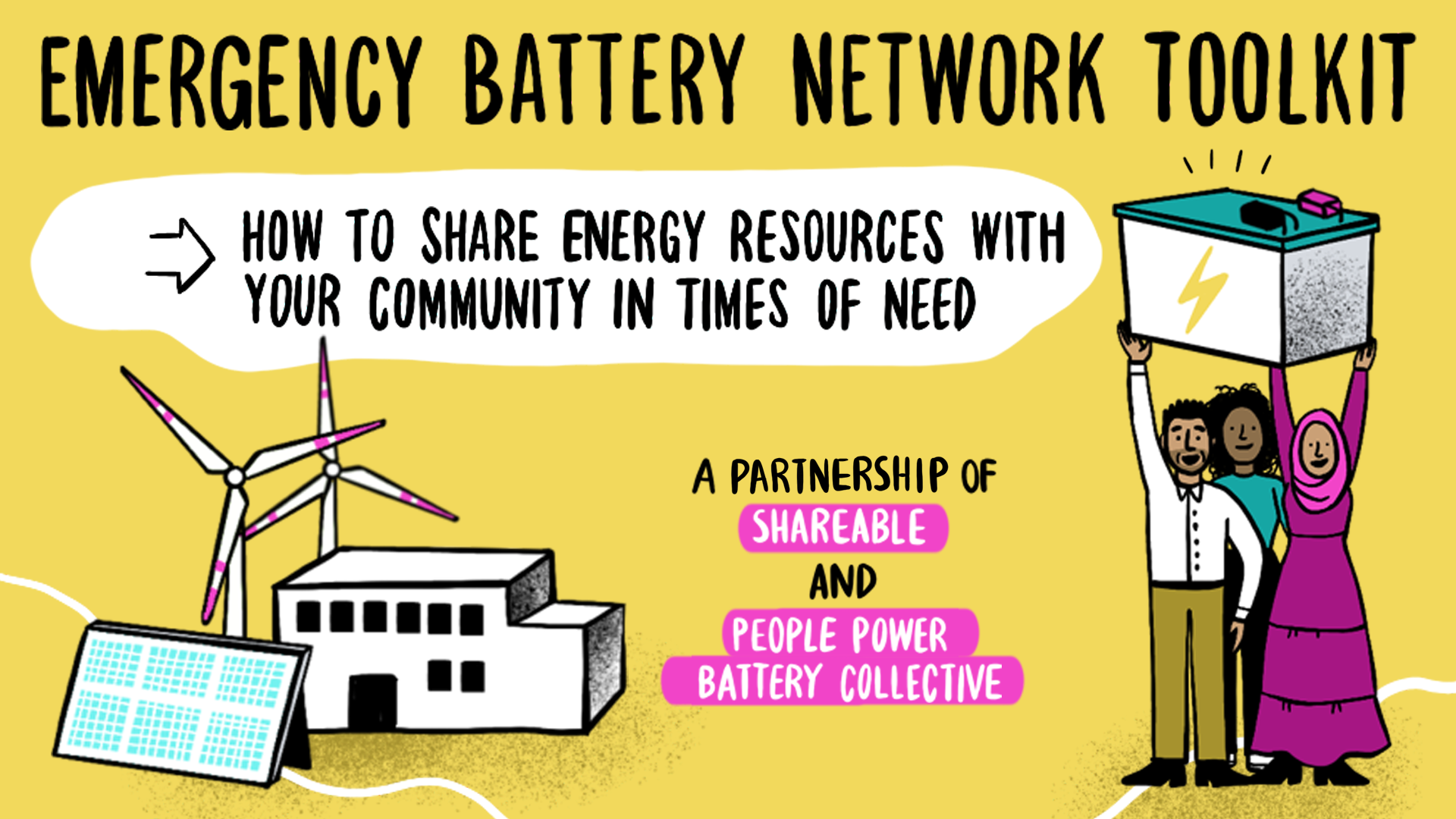
Table of Contents
Introduction
In the wake of blackouts, natural disasters, and catastrophes, we need solidarity more than ever. Vibrant and organized communities are the foundation of people-centered responses to the climate crisis. Backup power sources such as batteries, solar panels, and generators are expensive—and individualistic solutions aren’t very helpful in addressing our collective needs, especially in times of crisis.
That’s why Shareable partnered with People Power Battery Collective to create the Emergency Battery Toolkit to help organizers like you build strong and effective backup power supplies owned by local communities.
This toolkit is based on the work being done by People Power Battery Collective (a project of People Power Solar Cooperative), a self-organized mutual-aid collective in the San Francisco Bay Area, whose purpose is to provide backup electricity to support people who are facing power emergencies. Their experience is a successful model of what an emergency battery network can look like.
Members of an emergency battery network safely keep backup batteries until there is a need for power in the community. In response to power emergencies, the person in need connects with the battery holder and arranges delivery. When the emergency passes, the person who received power will recharge the battery to share with the next person experiencing a power emergency, creating an ebb and flow of resourcing within the community.
This Toolkit, which is centered around the recordings of the 2023 SolidarityWorks Emergency Battery Co-Lab, includes all trainings and ‘office hours’ (edited into bite-sized chapters), summaries of each lesson (including key takeaways), graphic recordings, customizable templates, and other resources.
We hope you’ll use this information to build an emergency battery network in your community. When you’re ready to launch, contact us (info@shareable.net) to get added to the (inter)national map!
 |
Free Download: “Emergency Battery Network Toolkit”In addition to the web toolkit, there are also interactive PDF and printer-friendly PDF versions.
|
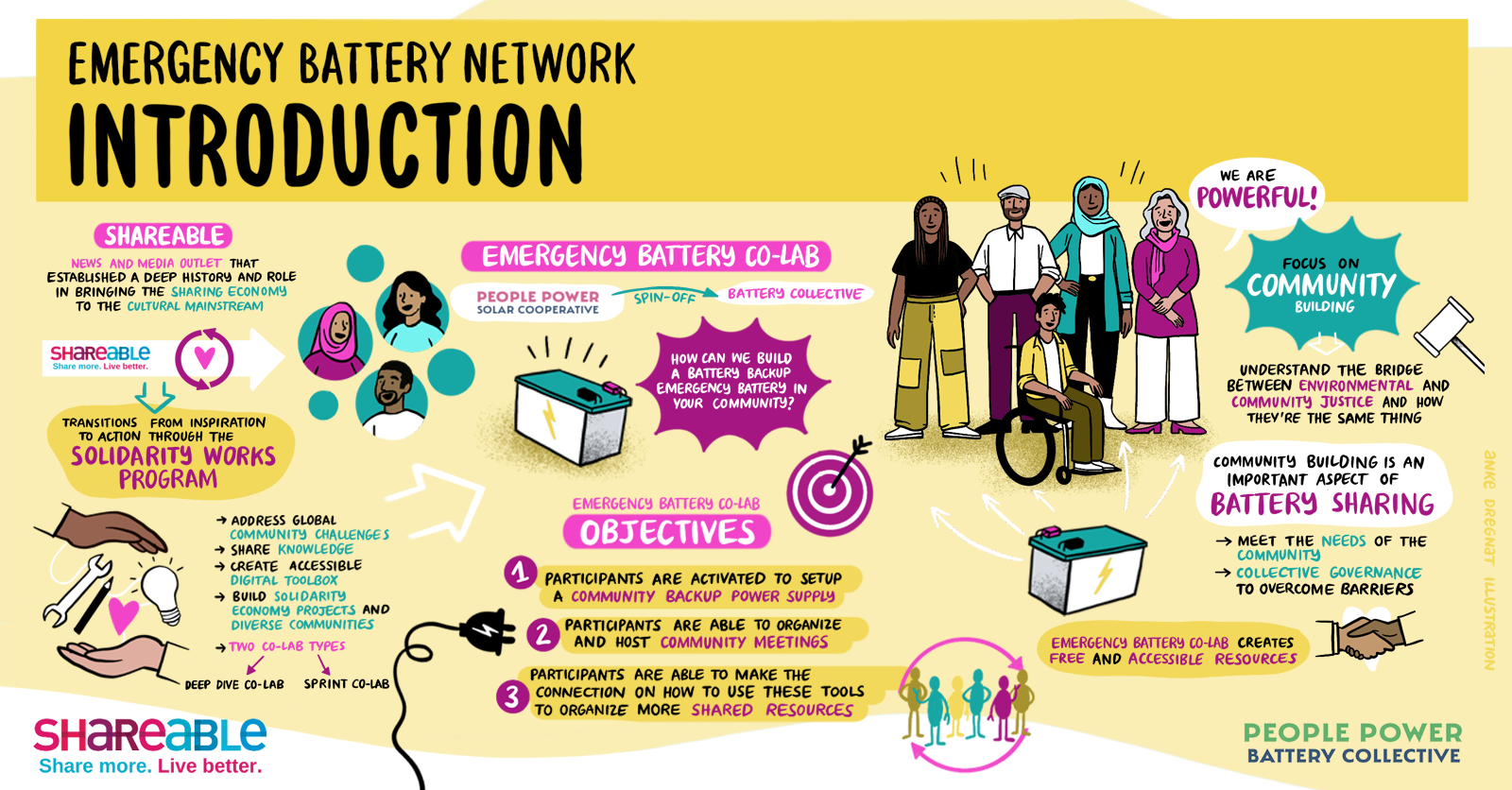
Training #1: Introduction
ITraining #1 provides an overview of the Emergency Battery Co-Lab, including the background and objectives of the training, with a primary focus on how to build a community to create your own local emergency battery network.
Objectives of the Emergency Battery Co-Lab:
- How to activate and set up a community backup power supply
- How to organize and host community meetings
- How to use these tools to organize more shared resources
Videos:
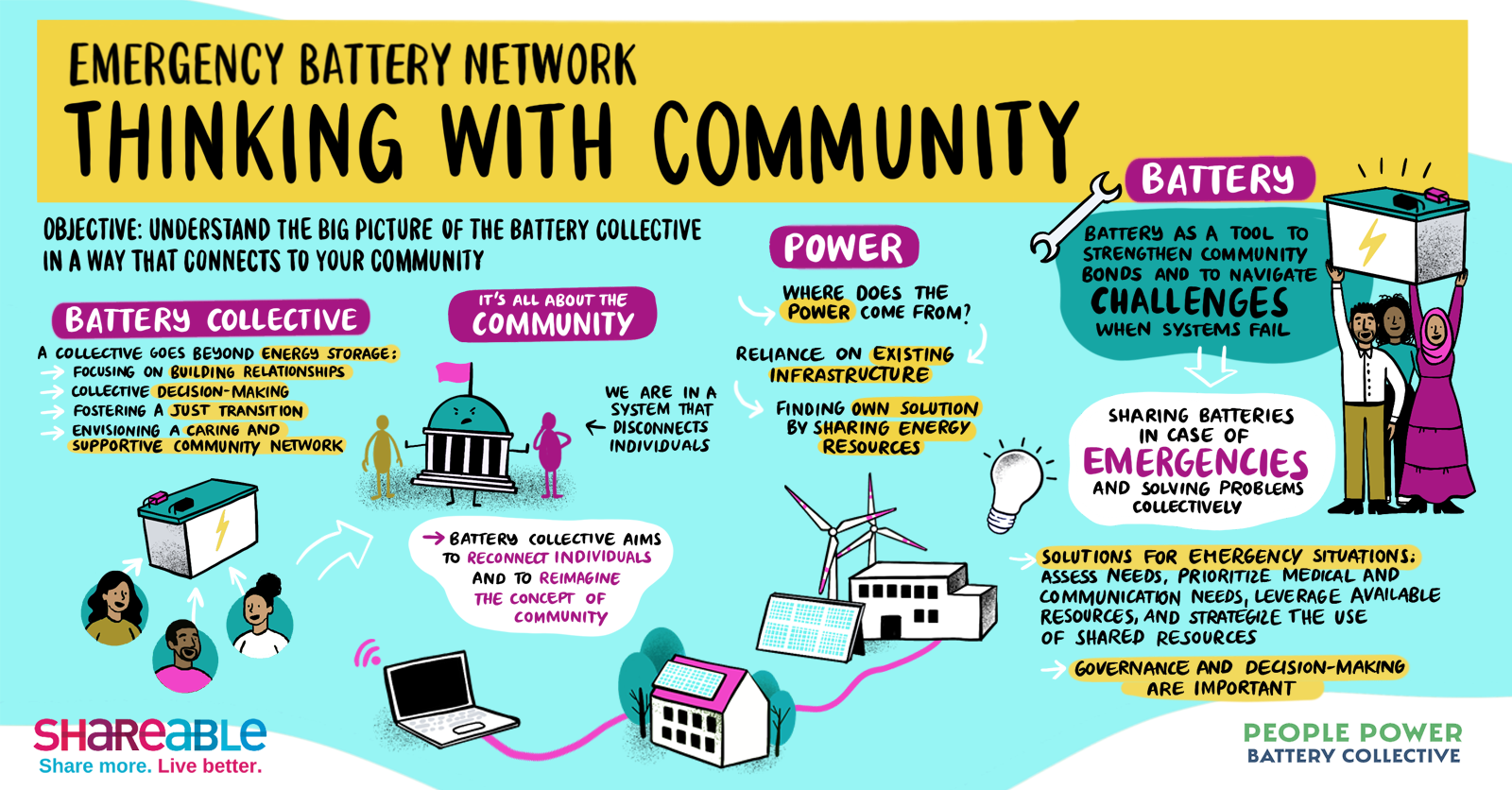
Training #2: Thinking with Community
Training #2 aims to help participants understand the big picture of an emergency battery network. Intentionally building community is the most critical part of building an emergency battery network, as it is the foundation that informs everything else: relationships, communication, norms, and an understanding of needs are all critical components.
Remember, solutions for every community will look different! There is no one right way to start an emergency battery network. The first step is reaching out to people and building foundational relationships.
Videos:
- Chapter 1: Introduction and Discussion (5:43)
- Chapter 2: Where We Come From Activity (8:02)
- Note: The “Where We Come From” activity was helpful for discussing the different emergencies participants of the co-lab faced in their own communities. When organizing your own emergency battery network, a discussion question could be, what emergencies does your community face?
- Chapter 3: What is an Emergency Battery Network? (5:13)
- Chapter 4: Simulation Scenario and Discussion (9:55)
- Simulation scenario: A situation has just arisen in your community, and two groups are without power and urgently need a battery. Fortunately, you have a community-shared battery at your disposal. In small groups, you will be working together to brainstorm a potential path forward to support these two groups needing a battery. This exercise is designed to challenge your critical thinking, collaborative skills, and decision-making prowess.
- Chapter 5: Governance Discussion (5:19)
- Discussion questions:
- How do we prioritize what’s classified as an emergency?
- How do we as a community, in these situations, prioritize what’s an emergency and what’s not an emergency?
- Discussion questions:
Key Takeaways:
- Focus on how you will build up a strong community network.
- In a communal setting, practice being able to discern what is and is not an emergency—one person’s emergency is not necessarily another person’s emergency.
- Consider how to ensure there are community-led solutions to emergencies so you do not solely rely on the private and public sectors for help in times of need.
- Emergencies are not always natural disasters. Social emergencies can include oppression, houselessness, food apartheid, and much more.
- Community involvement and collective action are paramount!
- Discussion Prompt: What does your community look like?
[Having an emergency battery network is about] much more than storing energy. It’s about building relationships and bonds that nurture resilience, learning what it means to work to make decisions collectively, and creating a culture around, [and] a force towards, a just transition. —Kansas, People Power Battery Collective
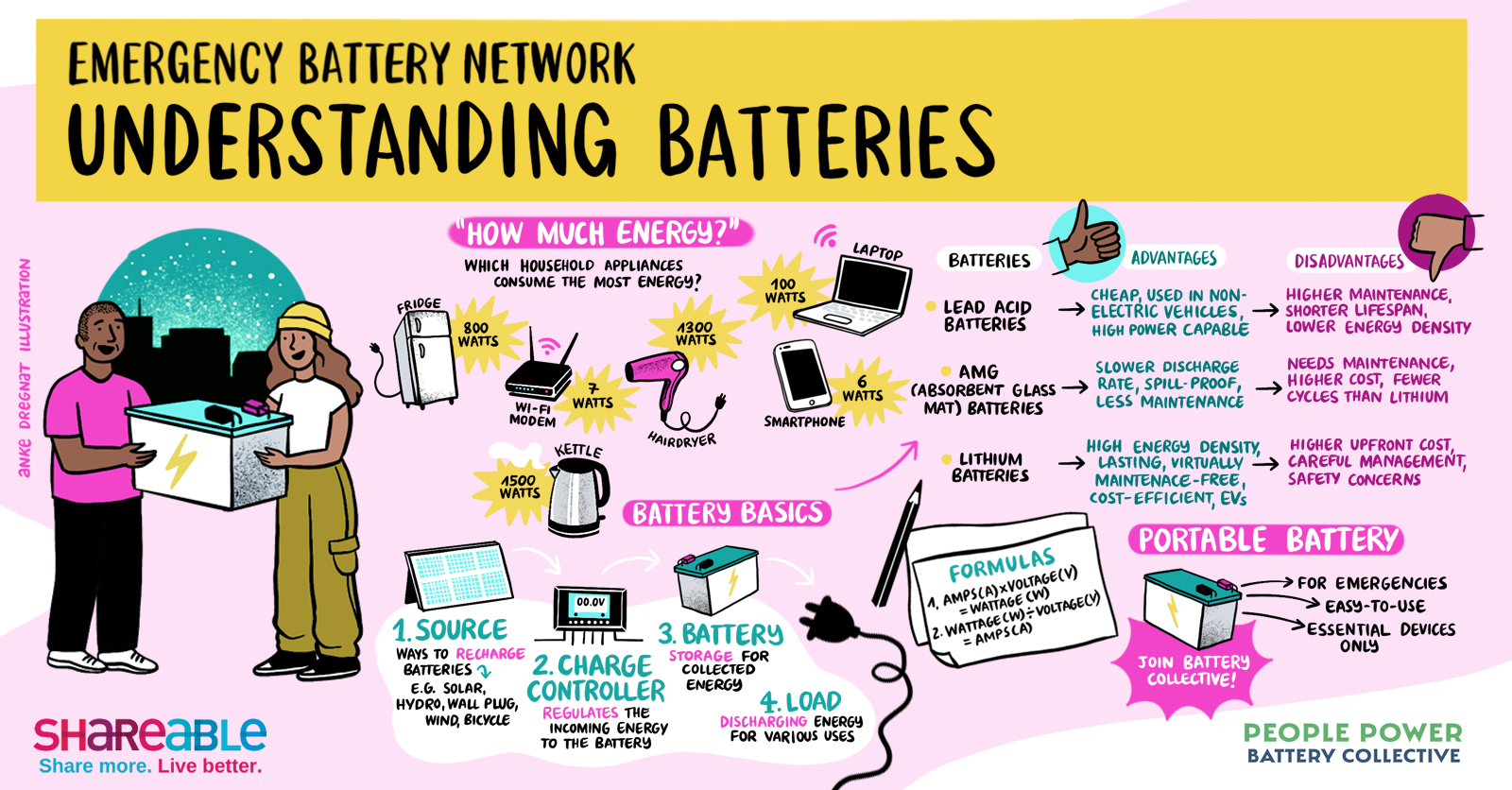
Training #3: Understanding Batteries
Training #3 aims to help participants gain knowledge about batteries, their management, and usage within an emergency battery network. While building strong community connections is absolutely essential to building a network, we also must understand how to use and maintain the batteries. There are a plethora of resources online, including videos on YouTube. Critically, this training also discusses the deadly mining process of lithium, colton, and cobalt (the key elements in batteries) in the Democratic Republic of the Congo.
Videos:
- Chapter 1: Introduction and Discussion (4:49)
- Chapter 2: How Much Energy Game (16:50)
- Chapter 3: Battery Basics (16:09)
- Chapter 4: Realities of Resource Extraction (4:58)
- Chapter 5: Battery Management and Care (1:39)
- Chapter 6: How to Use the Emergency Battery (2:19)
- Chapter 7: Discussion Wrap Up (2:39)
Key Takeaways:
- Consider how to set up a network of individuals who are dedicated to maintaining and sharing the batteries. What are ways you can try to ensure effective communication within the group?
- Think about who’s in your community and their emergency energy needs. Understand the wattage types of components needed to ensure those energy needs can be met in an emergency. Example: Someone in your community has medicine that must be refrigerated. Think about the energy required to power a refrigerator if there is a blackout and the coordination that would be needed.
- Takeaway question to think about: What’s our community minimum and maximum battery capacity requirement?
Note: While this Toolkit focuses on how to build your own low(er) cost batteries, you can also purchase/acquire pre-built battery systems from several companies.*
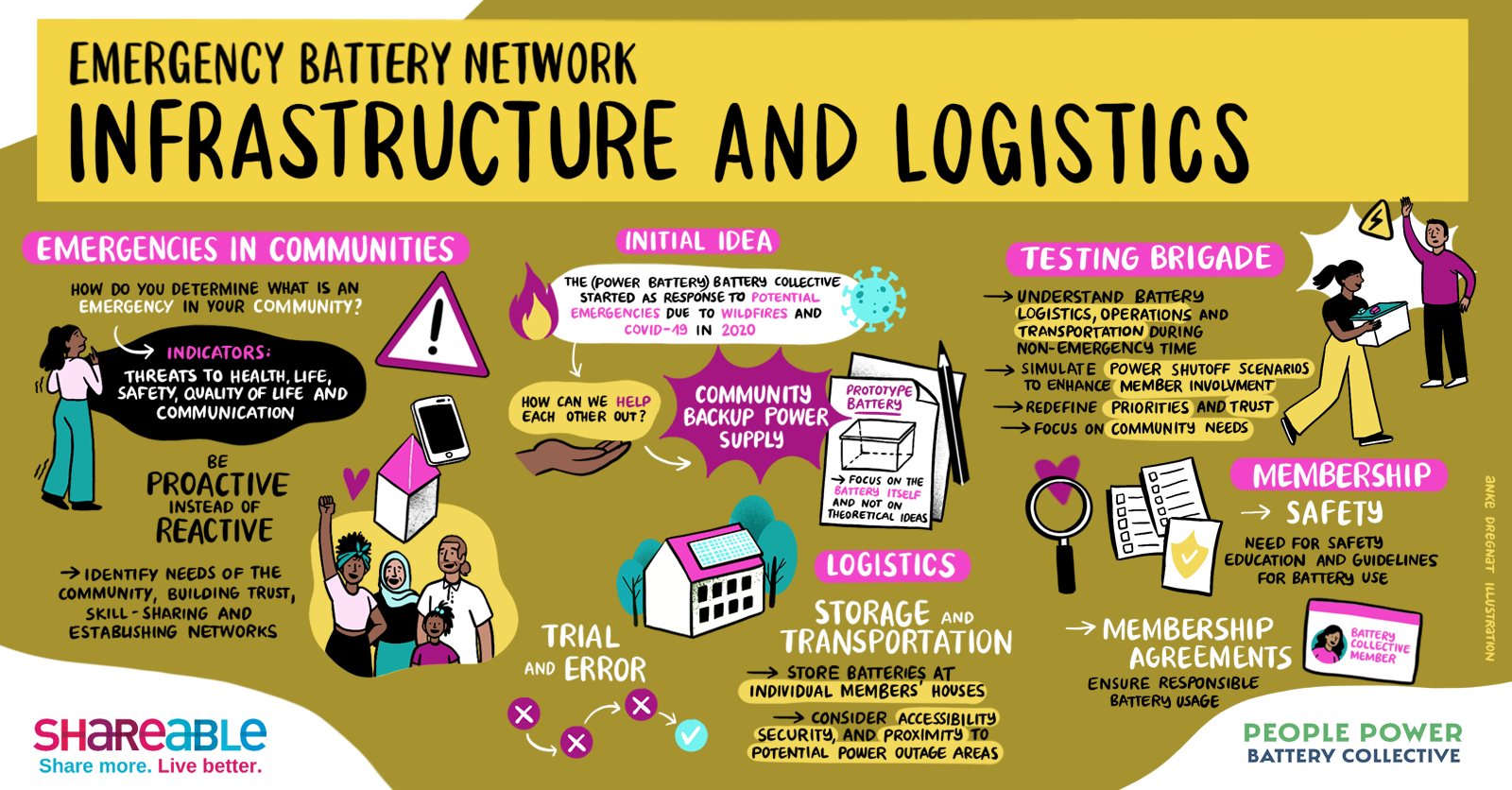
Training #4: Infrastructure and Logistics
Training #4 explores the key infrastructure and logistics of establishing and operating an emergency battery network. People Power Battery Collective shares their experiences and key lessons so you can apply them to your own organizing.
Every emergency battery network’s priorities, infrastructure, and logistics will look different. It’s important to not get bogged down in ‘what ifs’ and creating the ‘perfect’ plan on paper. Instead, dive in and embrace the learning process that comes from organizing with others!
Videos:
- Chapter 1: Community Battery Capacity Requirement Discussion (9:49)
- Chapter 2: Emergencies in Our Communities Discussion (7:31)
- Chapter 3: Infrastructure and Logistics Story (12:24)
- Chapter 4: Lessons from Non-Emergency Times (10:54)
- Chapter 5: Membership and Safety (5:20)
- Chapter 6: Membership Simulation Exercise (11:17)
- See templates at the end of the toolkit
- Chapter 7: Key Takeaways and Wrap-Up (2:47)
Key Takeaways:
- Evaluate the necessities and create alignment on what’s important to everyone in the emergency battery network.
- Be proactive instead of reactive.
- Embrace trial and error.
- Emergency battery network logistics to consider:
- Storage needs and requirements
- Transportation needs and requirements
- Security needs and requirements
- Membership process
- Battery educational basics
- Communication needs
- Lean into trust!
- Having an active network of people communicating makes it much easier to coordinate in emergency situations.
- Getting the word out to your community about your emergency battery network is important, people need to know the group exists!
- Remember that documentation and other logistical processes are important to ensure accountability and address potential liability.
I think a lot of people find out once they’ve gone through a disaster…one of the key takeaways that everyone can pre-plan for is the fact that there is no savior… As far as the resources that you and your family and your larger community will need, those are things that need to be planned out by the individuals, by that community. —Yasir, People Power Battery Collective
We’re learning that taking action is more powerful than endless debate… We’ve recognized that striving for a perfect blueprint can be paralyzing while focusing on realistic solutions can drive progress and learning. —Kansas, People Power Battery Collective
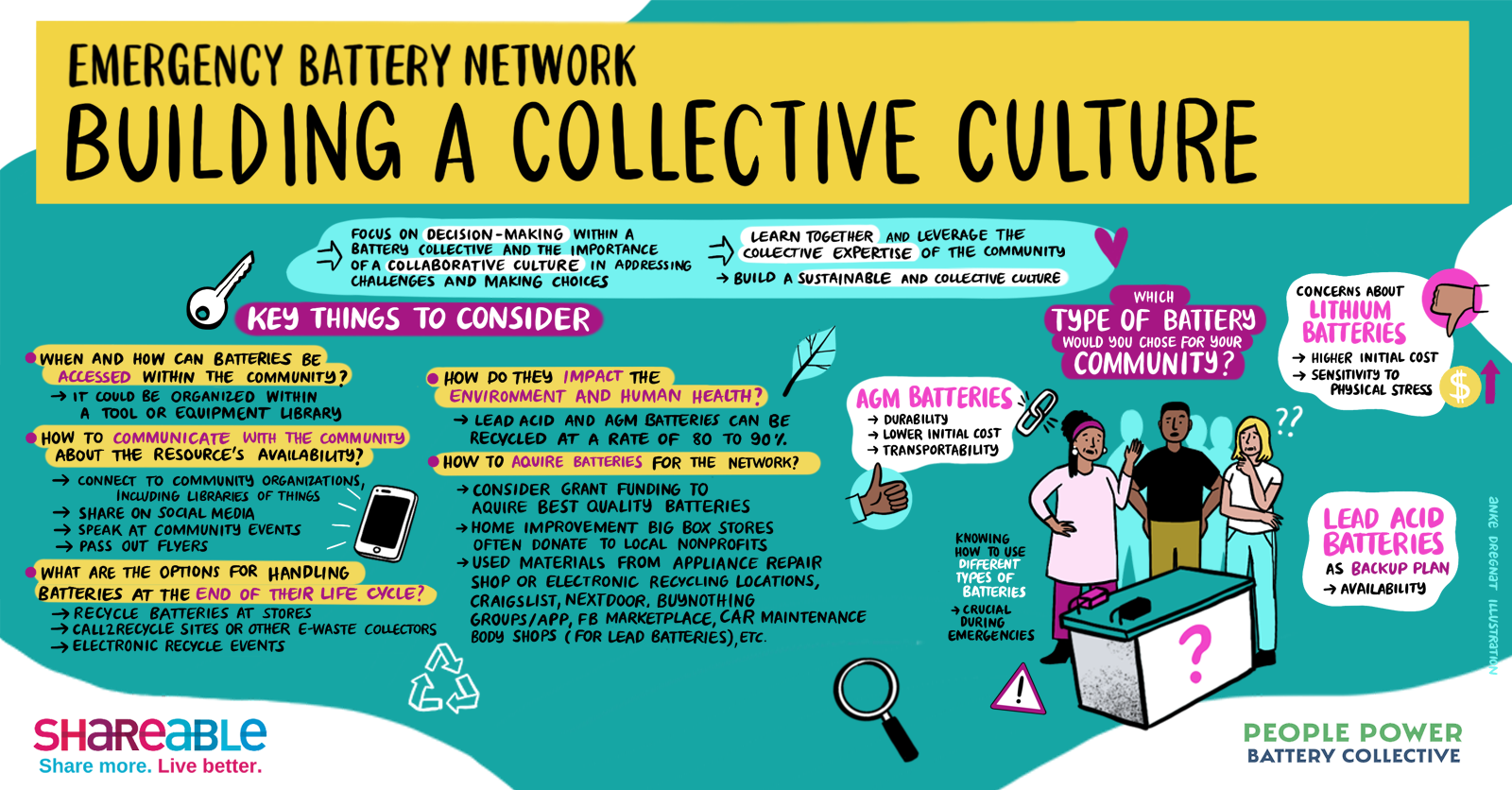
Training #5: Building Collective Culture and Operations
Training #5 explores strategies for building an organic and sustainable collective culture and addresses important governance and operational aspects of setting up an emergency battery network.
The collective culture will look different for every group and can only be built organically. Identifying the wants versus actual needs of your emergency battery network is important for taking action and problem-solving.
Videos:
- Chapter 1: Logistical Wants and Needs Discussion (9:37)
- Chapter 2: What Type of Battery Discussion (27:38)
- Chapter 3: What is Unanswered? Discussion (7:27)
- Chapter 4: Wrap-Up and Summary Discussion (3:37)
Key Takeaways:
- Identify the true needs of the present to help ensure that immediate needs, not wants, are met.
- Consider how you can start building an emergency battery network in your community. Simply talking to people is a critical first step! This can include friends, family, and neighbors.
A lot of times when we don’t know what’s the logistical want versus what’s the logistical needs, we end up getting bogged down with a lot of the potential things that are going to happen, which we later realized those are just logistical wants. —Crystal, People Power Battery Collective
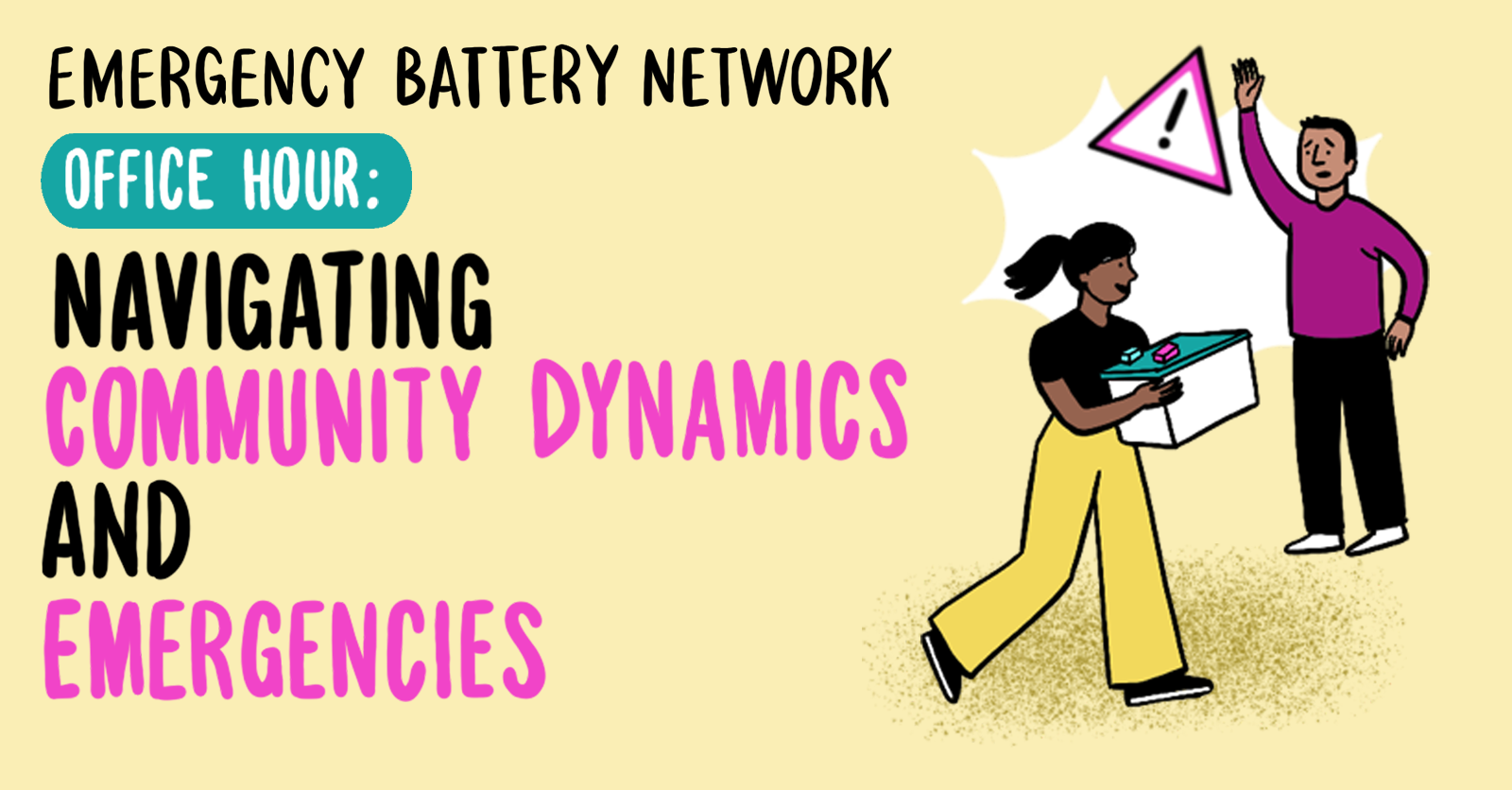
Office Hour: Navigating Community Dynamics and Emergencies
Session #6 focuses on discussions around navigating conflict and building community in an emergency battery network. It also includes a real-life emergency scenario discussion.
Videos:
- Chapter 1: Introduction, Navigating Conflict, and Building Community (12:34)
- Chapter 2: Real Life Emergency Scenario Discussion (18:53)
- Chapter 3: Discussion Wrap Up (8:59)
Key Takeaways:
- Actively invite people into your network’s community and develop that community! Identify different people’s skills and suggest possible roles or ways they could get more involved.
- There is no one-size-fits-all solution, every community is different! Think about what the needs of your community are and what your relationships are like.
- Conflict is inevitable. Remember that every group is different and there’s no right way. Allow the conflict to come up and develop a process with your community to address and navigate conflict.
- Center community-focused and community-led solutions.
- Think about how you are showing up in other communities—don’t have a savior complex!
- Prioritize accessibility for people in your community.
- Assess what tools and resources your network already has and what your network needs to create.
- An emergency preparedness plan can just be a document without the people and community that make it real and effective.
Nobody knows everything and together we know a whole lot. —Crystal, People Power Battery Collective
One of our hopes is that people will understand how to reach out to their community, how to get more people involved in their community, how to have those conversations. —Yasir, People Power Battery Collective
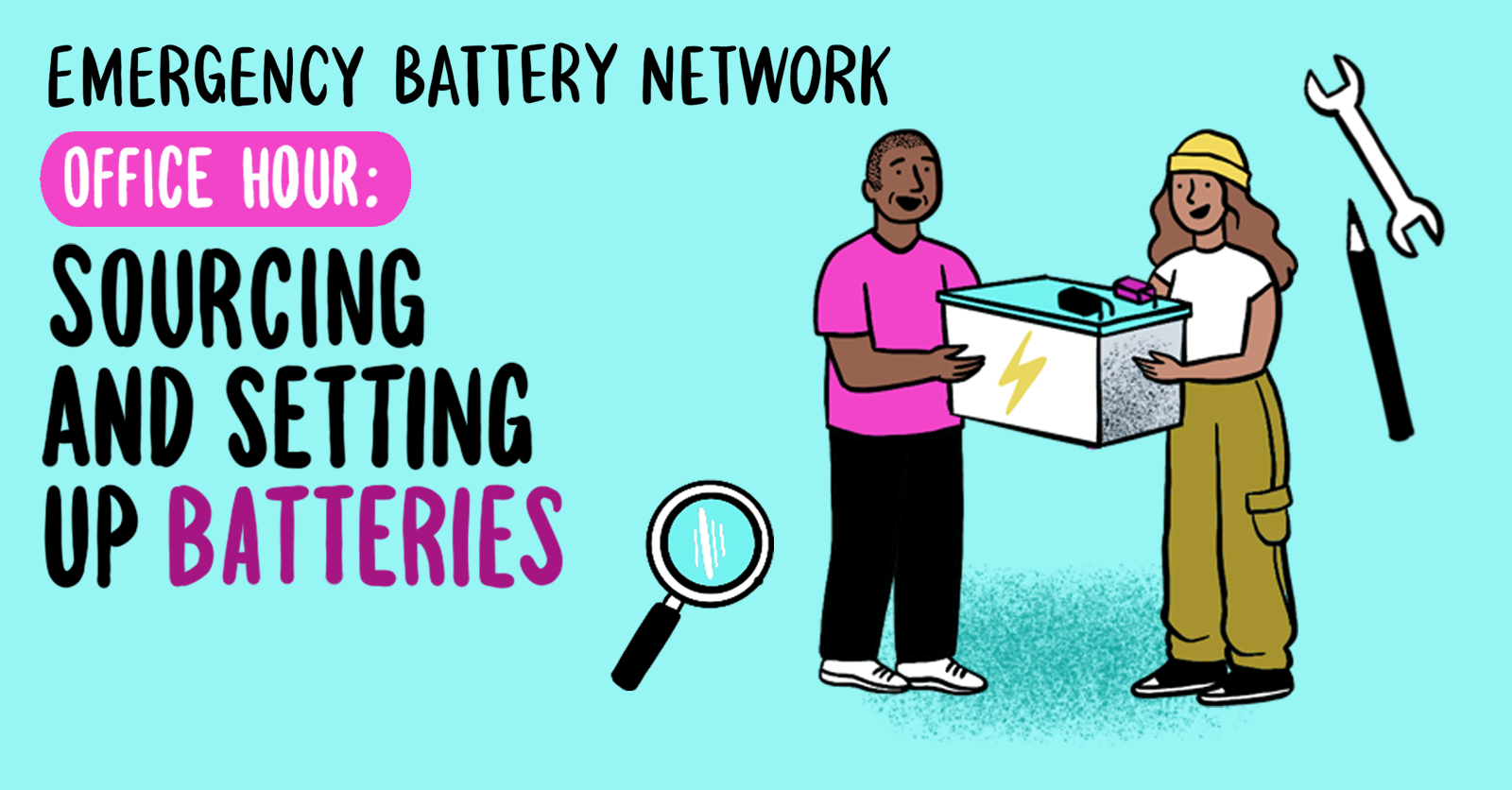
Office Hour: Sourcing and Setting Up Batteries
Session #7 focuses on a real-life scenario of sourcing and setting up a battery as a power source for a community event. Building community and reaching out to people is invaluable for sourcing materials and gaining knowledge for your emergency battery network.
Video:
Key Takeaways:
- Try to find batteries secondhand! Check sites like Craigslist and FreeCycle.
- Many batteries in medical settings are retired based on time, not capacity left, and could be a great option if there are some available in your area.
- Remember, the internet is a great resource, especially YouTube.
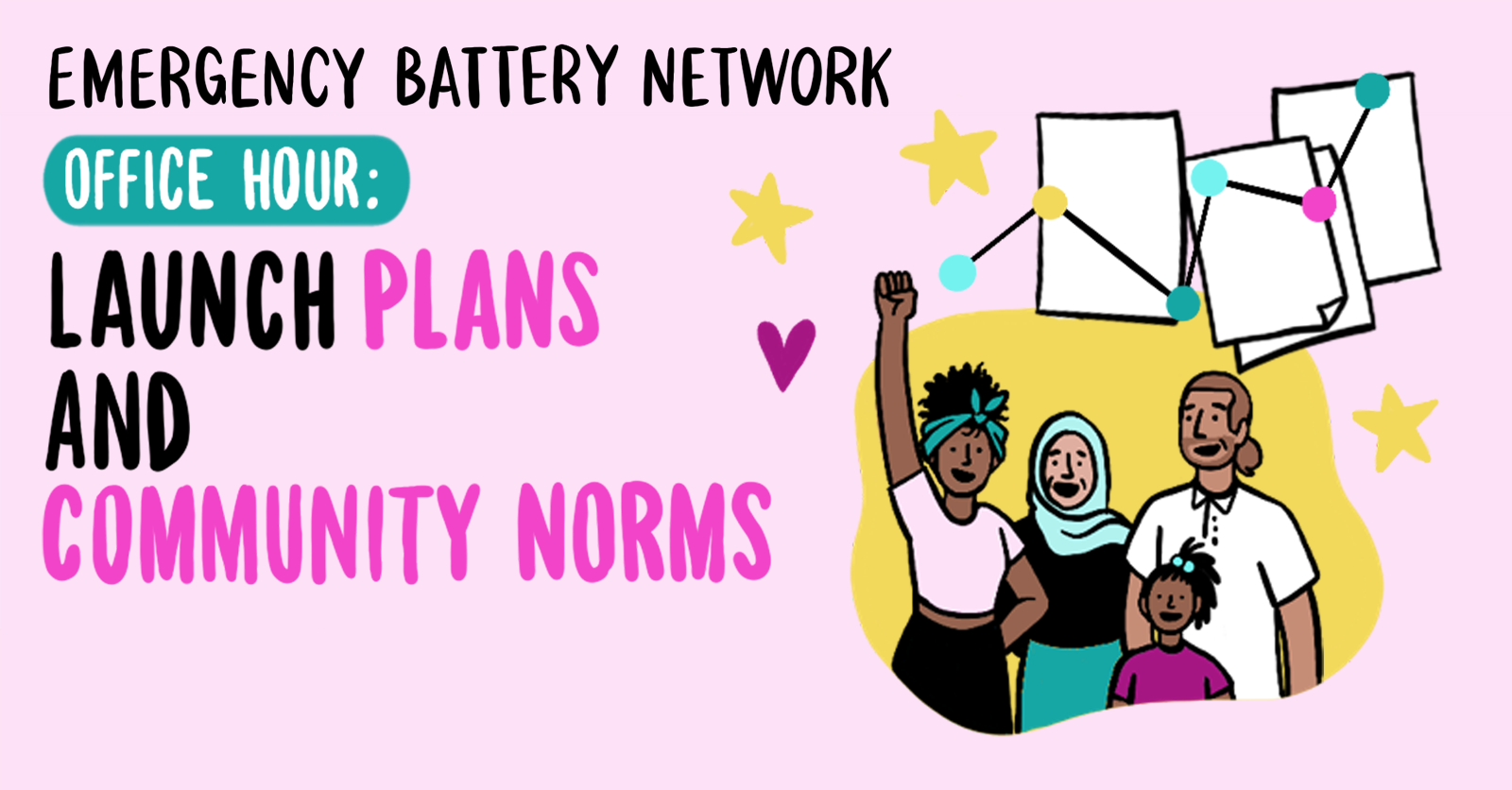
Office Hour: Launch Plans and Community Norms
Session #8 reviews the Co-Lab and opens up space for a discussion on launch plans and community norms.
Videos:
Key Takeaways:
- Remember that every emergency battery network will be different!
- An emergency battery network is for you and your community, it’s not a campaign and we’re not trying to appeal to big funders or politicians.
- Think about the people you see on a regular basis–-your neighbors, friends, and family members—and start talking to them!
- Privacy and safety is key. Be mindful of the personal information you ask of members and how you store personal data.
Templates
Please customize all templates for your network by changing the language, header images, questions, etc. When using the Google Forms, be sure to click on settings and change the Confirmation Message that gets automatically sent out after responses are submitted.
Resources
- Battery Basics (PDF)
- Emergency Battery Components Diagram (PDF)
- How to Build an Emergency Battery (Video)
- How Much Energy Game (Slides)
- Common objects/appliances energy use handout (GDoc)
- Battery Collective: How to Use/Charge the Shared Battery (Video)
- Wildfire blackouts got you down? Start a battery sharing collective like we did in Oakland (Article)
- How to Start an Emergency Battery Collective (The Original Guide)
- To learn more about People Power Battery Collective and the emergency battery network they initiated in the SF Bay Area, listen to this episode of The Response podcast: People Power Battery Collective with Kansas, Crystal, and Yasir (Podcast)
*While this guide is not endorsed or funded by any sponsors, Shareable receives a commission for purchases of pre-fabricated emergency batteries from Jackery. If you are going to purchase a battery from them anyway, please consider clicking through here to support the creation and distribution of this toolkit.
About the Project Team
Shareable is an award-winning nonprofit media outlet and action network with a mission to empower communities to share for a more resilient, equitable, and joyful world. In collaboration with global partners, we inspire social change through storytelling, advocacy, and organizing — with a mandate to prioritize high-potential, under-resourced communities.
Shareable’s new program, SolidarityWorks, is a learning and action lab designed to empower everyday changemakers to launch community initiatives that build solidarity. Through SolidarityWorks Co-Labs, we:
- identify concrete projects that can be replicated and adapted in other communities
- partner with practitioners to build a learning series and toolkit of collected wisdom to help new communities launch similar projects
- bring together a group of organizers in communities around the US and the world
- provide the support and resources to get those new projects off the ground
People Power Solar Cooperative was established as a Bay Area movement cooperative in 2018 to create pathways for communities to participate in the energy transition despite the lack of viable community solar policies. Rather than waiting for private utilities or corporations to do it for us, People Power With the mission to enable everyone to own and shape our energy future, People Power has a Project Group model set out in its Bylaws to create pathways for members to organize semi-autonomous energy projects that showcase that communities WANT TO and CAN own and shape our energy systems.
The People Power Battery Collective is a Project Group created in 2020 in the San Francisco Bay Area. As a self-organized, decentralized, grassroots mutual aid collective, the Battery Collective’s purpose is to provide backup power to support those who are experiencing power emergencies. Their Organizers work to facilitate a just and efficient method of managing and sharing energy resources among Participants and, by proxy, their communities.
This toolkit has been published with a Creative Commons license (CC BY-NC-ND 4.0.) You may copy and redistribute the material in any medium or form under the following terms:
- Attribution — You must give appropriate credit, provide a link to the license, and indicate if changes were made. You may do so in any reasonable manner, but not in any way that suggests the licensor endorses you or your use. This includes providing a link to the Toolkit on Shareable.net.
- NonCommercial — You may not use the material for commercial purposes.
- No Derivatives — If you remix, transform, or build upon the material, you may not distribute the modified material.
If you’re interested in the use of Shareable’s material outside of our CC license, please email us: info@shareable.net. We allow our material to be remixed or republished commercially on a case-by-case basis.


